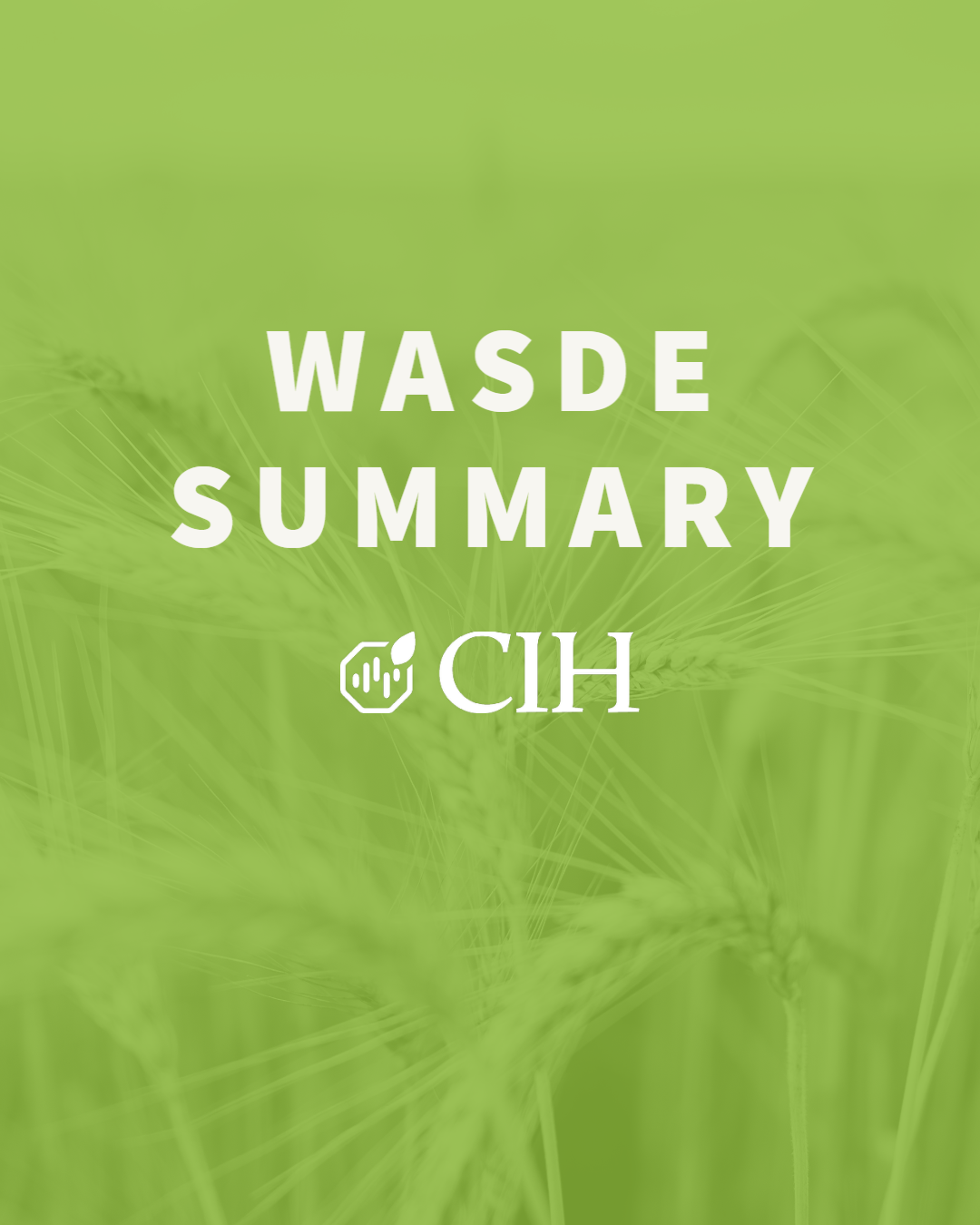
October 12, 2023
OCTOBER WASDE REPORT SUMMARY & NOTES:
The market’s price reaction to the October WASDE report was higher across the board for corn, soybeans and wheat. For this month’s production estimates of corn, cotton and soybeans, the WAOB uses objective field studies along with farmer surveys, satellite observations and certified FSA acres. Yields for both corn and soybeans were lowered from the previous month’s forecast, as expected, albeit slightly more than the pre-report analyst estimates. Yield estimates will be finalized in January. While national yields seem to be coming in below-trend for the last two years, the demand side of the equation continues to slump, particularly for corn. Market attention will begin to shift toward South American weather as well as continued international turmoil.
For corn, national average yields were lowered 0.8 bushels per acre to 173.0 compared to the pre-report estimate of 173.5. If realized, this would be the second consecutive year of below-trend yields, at the same time still within 2% of the highest recorded average of 176.7 bushels per acre. With no adjustments to planted or harvested area, the yield reduction amounts to an expected drop in production of 70 million bushels from last month to 15.064 billion bushels. If realized, this would represent the third largest production on record, 84 million bushels less than the 2016/17 crop year (15.148 billion bushels). On the demand side, feed and residual use is lowered 25 million bushels solely due to smaller expected supplies. Exports are also reduced due to the initially slow pace of demand to start the crop year. On the other hand, FAS export sales have seen a flurry of large flash sales in recent weeks, which has been encouraging for that demand category. Domestic ending stocks are projected down 110 million bushels from last month at 2.111 billion bushels with a resulting stocks-to-usage ratio of 14.72%. No major adjustments were made to the world balance sheet for this report.
Yields are expected to be slightly lower than last year, and the second consecutive year below trend:

Total production expected to still be near record:

FAS export sales have picked up in recent weeks and are now roughly 46 million bushels larger than last year at this time, or about 8.8% larger:

Ending stocks projected at 2.111 billion bushels, up from 1.361 billion in the 2022/23 crop year:

Stocks-to-usage ratio lower than last month’s projection, but significantly higher than the last few years:

For soybeans, national average yields were lowered 0.5 bushels per acre to 49.6 bushels per acre mainly due to lower production forecasts in Kansas, Michigan and Nebraska. Like the corn crop, if these yields are realized, this would mark the second consecutive year of below-trend yields. With no adjustments to planted or harvested area, the yield reduction takes production down 42 million bushels to 4.104 billion bushels. On the demand side, soybean crush is projected 10 million bushels higher to 2.3 billion bushels, while exports are expected to be 35 million bushels less than last month at 1.755 billion bushels due to increased competition from South America. The 2023/24 export forecast is roughly 12% below the previous crop year’s shipments, but current outstanding sales of soybeans are currently running 32% behind last year as reported by FAS. Despite adjustments to both sides of the balance sheet, soybean ending stocks we unrevised from last month at 220 million bushels and a stocks-to-usage ratio of 5.26%. On the global balance sheet, Brazilian ending stocks are expected to be 1 million metric tons lower due to lower beginning stocks and slightly larger exports. China’s ending stocks are also expected to be lower by 2 million metric tons due to lower beginning stocks and higher domestic usage.
Soybean yields expected to be slightly lower than last month’s forecast and on par with last year’s results:

Soybean production of 4.104 billion bushels would be the lowest since 2019-2020:

Soybean exports expected to be lower for the third consecutive year:

Cumulative soybean export sales for the current year running well behind last year according to weekly FAS export data:

For wheat, the updated balance sheet showed higher production as reported in last month’s NASS Small Grains Annual Summary, released on September 29. Despite lower planted and harvested area, all wheat yields were raised 2.8 bushels per acre to 48.6 bushels per acre. Total production increased by 78 million bushels to 1.812 billion bushels. On the demand side, domestic use was raised 30 million bushels due to the implied disappearance during the first quarter of the crop year (June ’23-August ’23) as reported in last month’s Grain Stocks report. With higher supplies outweighing higher demand, expected ending stocks are higher than last month’s forecast at 670 million bushels compared to 615 million bushels last month. On the global front, Russian wheat ending stocks are projected 1.5 million metric tons lower on smaller beginning stocks. Russian exports are raised 1 million metric tons to 50 million metric tons which is offset by lower domestic usage by the same amount.
All wheat yield increased m/m to 48.6 bushels per acre:

Production is forecast slightly higher than last month, and roughly 12% higher than last year:

Russian exports continue to rise:

Ukrainian exports unchanged at 11 million metric tons:
